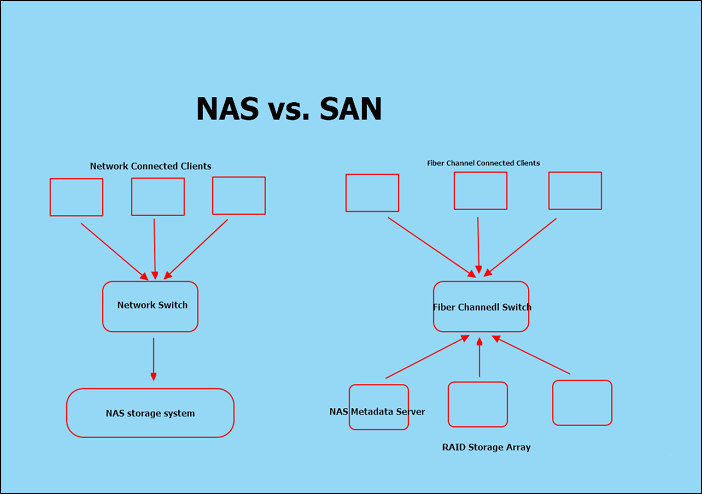SAN vs. NAS: A Thorough Comparison Between SAN & NAS
SAN vs. NAS: Different in Definition
What is SAN
SAN, Storage Area Network, also called Storage Network, is a computer network which provides access to consolidated, block-level data storage. SANs are primarily used to access data storage devices, such as disk arrays and tape libraries from servers so that the devices appear to the operating system as direct-attached storage. A SAN typically is a dedicated network of storage devices not accessible through the local area network (LAN).
(Information source: https://en.wikipedia.org/wiki/Storage_area_network)
What is NAS
Network-attached storage (NAS) is a file-level (as opposed to block-level storage) computer data storage server connected to a computer network providing data access to a heterogeneous group of clients. The term "NAS" can refer to both the technology and systems involved, or a specialized device built for such functionality (as unlike tangentially related technologies such as local area networks, a NAS device is often a singular unit).
(Information source: https://en.wikipedia.org/wiki/Network-attached_storage)

SAN and NAS differ in many aspects. Here are their corresponding specifications, through which you can clearly distinguish between both.
| SAN | NAS | |
|---|---|---|
| Storage Types | Block-level storage | File-level storage |
| I/O Protocols | iSCSI/FCP/FCoE/FC-NVMe | NFS/CIFS |
| Connection Channel | Fiber | Network |
| Price | Expensive | Less expensive than SAN |
| LAN-based | No | Yes |
| Main Features | High performance and low latency | Ease of use, data manageability, scalability, and lower cost of ownership |
| Applicable Scope | For professional and large companies use | Widely used for small and medium-sized business or home |
SAN vs. NAS: Different Applicable Scenarios
The Applicable Scenarios of SAN
SAN is mainly designed to improve the application performance by separating the storage traffic from the rest of the LAN. Its high, fast input and output process speed and low latency make it a perfect choice for processing business-level critical databases.
Some common examples of using SANs include Microsoft SQL Server databases(Often the most valuable for enterprises), Oracle databases(Also essential data for business), and Virtualized environments that need large-scale deployments, like large virtual desktop infrastructures.
The Applicable Scenarios of NAS
NAS is featured for data sharing on multiple devices. So NAS is an ideal tool for organizations of any size to store and share files centrally. Combining multiple servers on the same NAS device is convenient for work collaboration and easy to store and manage centralized flies.
NAS is suitable for large volumes of unstructured data storage, like videos, audio, Microsoft documents, text files, etc.
Three common types of NAS are available there. Enterprise NAS is mainly used by companies needing large storage space. Midmarket NAS is more suitable for small businesses with hundreds of TB data storage needs, and Desktop NAS is cheaper and used for personal or home purposes.
SAN vs. NAS: Pros & Cons
The pros & cons of SAN
| SAN | Data recovery service provider | Hard drive data recovery software |
|---|---|---|
|
|
The pros & cons of NAS
| NAS | Pros | Cons |
|---|---|---|
|
|
SAN vs. NAS: Which One to Choose
Both SAN and NAS are solutions to centrally store and share data accessible to multiple servers and users.
But NAS is based on a Network to switch, while SAN is Fiber-based. NAS provides both storage and file systems, while SAN provides only block-based storage, leaving the file system to the clients.
But that doesn't mean SAN and NAS are mutually exclusive. You can combine the two to form a NAS-SAN complex that provides file-level and block-level protocols from the same system.
Which one to choose relies on your actual situation. If you have professional IT staff and have a large volume of data storage needs. SAN is a better choice. NAS is easy to use and manage and more suitable for common applications.
Related Articles
- What Is Windows 10 Kiosk Mode and How to Set Up It?
- How to Boot from USB on Different OSs [Step-by-Step Guide]
- Full Guide on Windows 11 Requirements [Everything You Should Know]
- What is USB 4: All You Need to Know [ 2022 Complete Understanding]